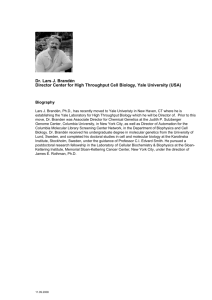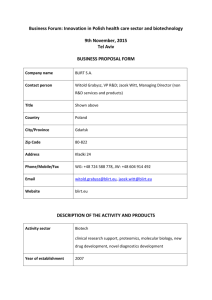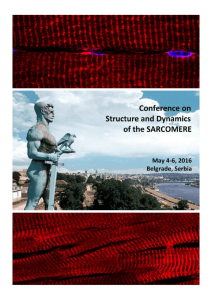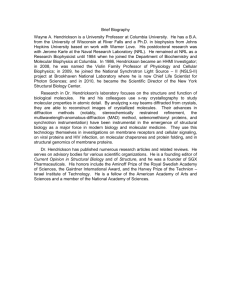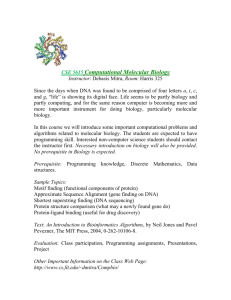Use of Molecular Dynamics in Biophysics
advertisement
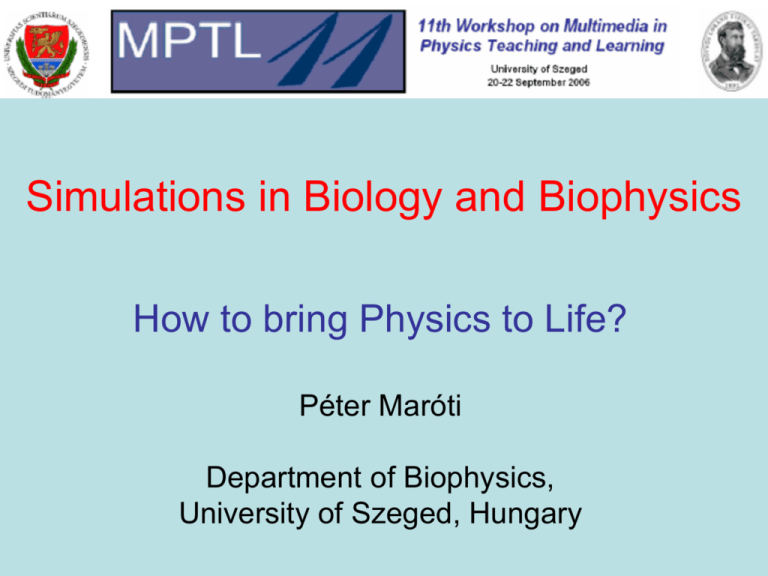
Simulations in Biology and Biophysics How to bring Physics to Life? Péter Maróti Department of Biophysics, University of Szeged, Hungary Topics - (Young) physicists: face to biology (related problems) - (Bio)Molecules in motion: brief tutorial on molecular dynamics (MD) - Applications - K+ channel protein - aquaporin - titin - photosynthetic apparatus of bacteria - harvesting the sun - temperature dependence of intraprotein electron transfer - interquinone electron transfer coupled to proton uptake - protein and lipid control of energetics of QA (effect of mutations) Physics in Biology, Biological Physics, Biophysics In 1944, the physicist Erwin Schrödinger, published a short book that changed the course of modern biology. "What is Life?" he asked famously in his title. Could the events inside a living organism be explained solely by physics and chemistry? Yes, they could, Schrödinger answered. "The obvious inability of present-day physics and chemistry to account for such events is no reason at all for doubting that they can be accounted for by those sciences.„ At that time, there was a wide disconnect between physics and biology. No one knew - the physical nature of a gene, - the molecular biology, and - many of the smartest scientists went into elementary particle physics. No more today. ''Ask not what physics can do for biology,'‘ said Hans Frauenfelder, one of the field's pioneers, ''Ask what biology can do for physics.'' . (Adaptation of famous phrase from J.F. Kennedy) ''Biology has provided physics with its new frontier,'‘ said Robert Laughlin, who won the 1998 Nobel prize in physics (quantum Hall effect) and now devotes himself to theoretical problems in biology. ''The whole problem is that we are living in the 21st century with these 19th century guilds.'' said John Hopfield, a Princeton scientist, one of the first physicists to move into biology. Molecules in Motion Structural biologists have long determined the detailed threedimensional structures of proteins and the cell's other macromolecules, pinpointing the position of the thousands of component atoms. Those structures offer clues about how proteins act as • motors, • channels, • solar cells, or • genetic switches. But the structure is just a starting point. To begin explaining how a protein functions, it's important to see how it moves. The need is large to make successful simulations of macromolecules at work: Molecular Dynamics (MD). Experiments that show protein dynamics Hemoglobin Bacterial Reaction Center O2 H+ The oxygen would need seconds to diffuse through the protein matrix to the hem groups in rigid protein. However, the time scale of oxygen uptake is ms! Hans Frauenfelder, PNAS 1979 The rate of proton uptake from the aqueous bulk phase is governed by the dynamics of exposure of the protonatable group of the protein. P. Maróti and C.A: Wraight, Biophys. J. 1997 Speed up Use of Molecular Dynamics in Biophysics A Brief Tutorial on MD Simulations MD: The Verlet Method Double V-shape Obtaining files Files can be downloaded through the Web First, you need a PDB File What you need to know to build a realistic atomistic model of your system? What you need to know to build a realistic atomistic model of your system? MD Simulations of the K+ Channel Protein Temperature fluctuation Water Transport in Aquaporins Aquaporins are membrane water channels that play critical roles in controlling the water contents of cells. The Nobel Prize in Chemistry for 2003 Peter Agre Johns Hopkins University School of Medicine, Baltimore, USA “for the discovery of water channels” Fundamental molecular understanding of how the kidneys recover water from primary urine. Several diseases, such as congenital cataracts and nephrogenic diabetes insipidus, are connected to the impaired function of these channels. Aquaporins facilitate the transport of water and, in some cases, other small solutes across the membrane. However, the water pores are completely impermeable to charged species, such as protons, a remarkable property that is critical for the conservation of membrane's electrochemical potential, but paradoxical at the same time, since protons can usually be transferred readily through water molecules. Water Transport in Aquaporins Emad Tajkhorshid, Peter Nollert, Morten Ø. Jensen, Larry J. W. Miercke, Joseph O'Connell, Robert M. Stroud, and Klaus Schulten. Control of the selectivity of the aquaporin water channel family by global orientational tuning. Science, 296:525-530, 2002. 12-nanosecond molecular dynamics simulations were carried out that define the spatial and temporal probability distribution and orientation of a single file of seven to nine water molecules inside the channel. Two conserved asparagines (Asn 68 and 203) force a central water molecule to serve strictly as a hydrogen bond donor to its neighboring water molecules. Assisted by the electrostatic potential generated by two half-membrane spanning loops, this dictates opposite orientations of water molecules in the two halves of the channel, and thus prevents the formation of a "proton wire," while permitting rapid water diffusion. Yellow ball: selected water molecule (or small salute). Dozens of rounded red and white water molecules swarm around the much-larger channel like bees; a line of them squeeze singlefile through a narrow hole in the channel’s center. Halfway through, each water molecule flips 180 degrees. In the extreme sport of bungee jumping, a daring athlete leaps from a great height and free-falls while a tethered cord tightens and stretches to absorb the energy from the descent. The bungee cord protects the jumper from serious injury, because its elasticity allows it to extend and provide a cushioning force that opposes gravity during the fall. Amazingly, nature also uses elasticity to dampen biological forces at the molecular level, such as during extension of a muscle fiber under stress. The molecular bungee cord that serves this purpose in the human muscle fiber is the protein titin, which functions to protect muscle fibers from damage due to overstretching. Forced unfolding of titin Z1Z2 Molecular Bungee Cord 750 pN Photosynthetic Apparatus of Purple Bacteria. Some problems for MD simulations 1. Harvesting the Sun The light harvesting system displays a hierarchy of integral, functional units How does the Light Harvesting System function with thermal disorder? How does Q/QH2 pass through LH-I to/from RC within reasonable time (≈1 ms)? 2. Temperature-dependence of the rate of the initial electron transfer The electron transfer is coupled to the thermal motion of the surrounding protein. 3. Interquinone Electron Transfer. Effects of Mutations HisM219 QB HisL190 e- QA Fe HisL230 M266His M234Glu H+/QA- proton uptake 0.5 WT 0.25 Mutants 0 1 H+/QB- proton uptake Extended network of strongly interacting protonatable groups a b WT 0.5 Mutants 0 6 H. Cheap et al. Biochemistry (submitted) 7 8 9 pH 10 11 WT ■ M266HA O M266HL □ Delocalized proton uptake: the cytoplasmic part of the RC acts as proton sponge. The high pH band of proton uptake reflects interaction among protonatable residues. 4. Protein (M265ILE and M252TRP) and lipid (cardiolopin) control of QA/QA- midpoint potential László Rinyu et al. Biochim. Biophys. Acta 2004. The free energy drop from P* to P+QA- in mutants at residue M265 of the QA binding site. ΔGP*A was determined from the intensity of delayed fluorescence. The effect of cardiolipin and M252WF mutation on the delayed fluorescence emission (DF) from RCs. Trp→Phe mutant Wild type Thermodynamic box QA Gdissociation RC-QA Q A / Q A G bound RC-QA- RC + QA G 0 Q A Gdissociation Q / Q G free RC + QA- Linear Interaction Energy (LIE) method for determination of ligand binding free energies J. Aqvist and J. Marelius, Combinatorial Chemistry and High Throughput Screening, 2001 This method is based on force field estimations of the receptor-ligand interactions and thermal conformational sampling. A notable feature is that the binding energetics can be predicted by considering only the intermolecular interactions between the ligand and receptor. QA Q A G G Direct calculation of dissociation dissociation and from MD model and determination of the change of the midpoint redox potential from the thermodynamic cycle. Q Mutant M265IT A Wild type G dissociation Acknowledgements. Thanks to • László Rinyu – Ph.D. student • OTKA
